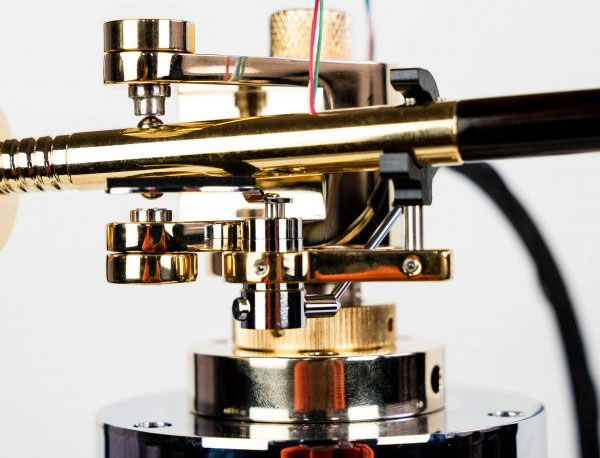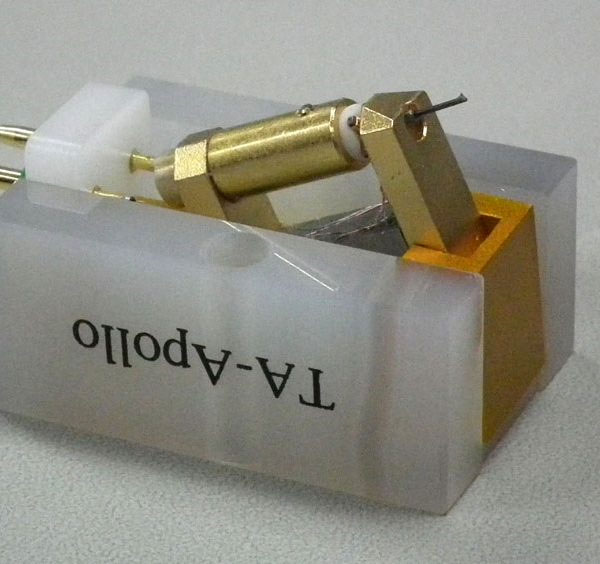The first system consists of two massive, 3-inch thick composite chrome platters, each tipping the scale at 50 pounds, which together form the rotating structures, with the bottom platter pulled by belt via a high torque AC motor controlled by a sizeable outboard quartz digital speed control. The colossal bottom platter spins the top platter via a stainless steel shaft. The ball bearing is CNC titanium and coated with diamond!
Clearly not daunted by prospects of budget, Tom’s approach is extravagant, to say the least, as if having created a massive, 50-pound metal alloy platter is still not extreme enough for his second-best product. I can almost hear him say something along the lines of, “Let’s create an unprecedented, massive colossus for a platter to dampen any possibility of vibration. Now that it’s done and looks even prettier than imagined, we’ll double it up into two massive alloy platters for the ultimate in sound and physique!”
Adding to the spectacular physique of the turntable are two superstructural plinths, each 1.5 inch thick and weighing almost as much as the platters, milled from single pieces of the same alloy. Each of the plinths resembles a massive, curving trigonal structure, with the lower plinth serving as the foundation for the rotating platters; three colossal feet of the same alloy are inserted into its vertices and elevate the lower plinth 4 inches off the ground. This completes the first system.
The second system begins with the top plinth. Two outward bridges of the same alloy extend from the rear left and right of the plinth to form two armboard bases. This plinth sits atop the first plinth via three shorter but equally supersized feet, thus forming a structure for the armboards that is isolated and independent from the structure for the platters. The center of the top plinth is hollowed out to house the top platter without touching it. The AC motor is housed in a large cylinder of the same alloy and placed beneath the left armboard. This completes the second system.
The mass of the turntable is further increased at the point of contact with the couplers by use of downward alloy cones built into the feet. While weighing 200 pounds, the turntable’s induced inertia at the point of contact on the bottom-coned feet is mindboggling. An enormous brass record clamp is included. It is first placed on the record and then tightened by holding the bottom clamp with one hand and turning the top section clockwise with another until secured. The clamp is released by turning the top section counter-clockwise.
After the initial setup, I deemed the speed of the turntable to be minutely off. Via the iOS app Turntabulator that Tom recommended, the rotational speed was shown to be at 33.20 RPM. A slight turn of the trim pot on the outboard control unit sped up the spin to 33.40, at which point the app proclaimed “IDEAL.” Running slightly fast like this makes sense, as the drag of the cartridge must be taken into account as well.
The Osiris MkII 12-inch tonearm is the first tonearm in the history of the product category to use a magnetic bearing, and it’s fitted to a unipivot no less. A small, powerful neodymium magnet takes the place of a conventional tonearm bearing and hangs the arm tube in air. The magnet is positioned on the underside of an overhead structure and seizes on a metallic pot on top of the arm tube and holds the arm tube in place. Therefore, rather than having to combat its own mass on a unipivot point in groove tracking, the tonearm is hung from above. The miniature magnet is strong enough to resist my initial attempt to pull the tonearm off. VTA adjustment is easily accessible via a screw, and since the tonearm sways freely in midair, tracking angle is preserved after initial adjustment.
The Osiris MkII’s arm tube is made of Ebony Makassar wood with a brass housing. This wood tonearm is not the same as the choices of material on similarly priced competitive arms, such as light and rigid alloys or even carbon fiber. However, the arm tube is designed to accommodate the two brass counterweights included and both are to be used even with the 11.9 grams of the Apollo. Tom’s customary reluctance in divulging technical details means all is in the listening. The tonearm’s specified cartridge range of 6 to 18g means care should be taken in selecting cartridges within that range; speaking for myself, I’d love to have the freedom to use some uber expensive and heavy cartridges on the Master Reference turntable, given its price class. Maybe Tom will create a linear-tracking arm with no practical cartridge range limitation. Lastly, the tonearm is wired with 99.9999 cryogenically treated silver wire and fitted with RCA connectors. At the opposite end, the cartridge connectors in the headshell are sturdier and more substantial than in all other headshells I’ve seen. With an effective mass of 35 grams at the highest, the Osiris MkII is a very high-mass offering.
The 12-inch arm was a markedly superior tracker. Music embedded in the inner groove was now endowed with a better-defined midrange and top-end. Coupled with the magnetic-bearing, free-swaying tonearm, the musical experience was utterly transformative. It felt more assured and relaxed even as the music progressed into the inner groove; the musical legitimacy this system accorded all of my albums cannot be overstated.
The supplied Triangle Art Apollo Onyx Stonebody utilizes an Alnico magnet on a solid boron cantilever, its core wound in special copper wire, plus a VS1-grade diamond stylus. The assembly is then mounted directly to the machined Onyx enclosure. With an open bottom, the feedback elimination property of this Stonebody design is promising. Weighing 11.9 grams, the Apollo sits right at the medium weight of cartridges suitable for the Osiris arm. The Apollo’s 0.3mV output makes the use of phono stages capable of extra high gain and rare refinement, such as the Pass Labs Xs Phono stage, mandatory. Sporting a 12 um/mN compliance, the Apollo is considered low-compliance and thus a fitting partner to the Osiris MkII.
The Apollo’s use of Alnico magnet reminds me of the sweet tone and sense of dynamic ease of the discontinued 47 Laboratory Miyabi/47 moving-coil.
Playing the recently reviewed Reference Recordings Saint-Saens Symphony No. 3, the very natural, uninhibited flow of notes resplendent with effortless dynamic recreation pulled me into a soothing sonic plane that is uniquely analog. It was not a tubey, euphoric presentation, though, for the Master Reference system carried the heavy notes of the brass section and the pipe organ, full, reverberant and gritty; there’s the edge that gives rise to such fragrancy to the sound of the record. Instrument textures and tonalities were all the more developed and better defined through the Master Reference.
The level of resolution attained by this analog rig was palpable, which I attribute to the massive platters’ and plinths’ combined ability in damping every single hertz of vibrational frequency and energy. The system demonstrated a top analog playback system’s manner in extracting every strand of audio energy, with superior spatial definition and separation of instrument groups. In my listening space, the Master Reference system produced a sense of energy that rendered the sound virtually three-dimensional.
But at the asking price of $39,900 for the turntable alone, the TriangleArt had better be capable of more magic, and indeed it was.
For the first time in my listening experience, the TriangleArt system revealed Sir Georg Solti’s 1961 London FFRR recording of Mahler Symphony No. 4 to carry subtler instrumental cues than his 1984 Decca digital with the Chicago Symphony Orchestra, some twenty-three years later, and yet shockingly no less expedient in emotional urgency and tempo. The 3rd Movement, in particular, elicits some of the most powerful emotions from the listener. The degree of textural transparency as accorded by the mechanical interpretation of the energy generated by the Apollo and carried onward by the Osiris MkII was one of a kind, and the defining sonics made it highly communicative and evocative.
There was also high drama in the twenty-minute roller coaster ride as picked up by the Apollo, which transmitted the energy in the composer’s larger, more emotionally charged works, which are often eulogistic to his deceased daughter and wife. Just as Gary Oldman’s Beethoven character in “Immortal Beloved” related with Schindler that,” It is the power of music to carry one into the mental state of the composer. It is like hypnotism.”
The envelope-pushing prowess of the Master Reference turntable system produced a sound so utterly realistic and rich that it lent palpable power to the music. Sometimes, when this basking of ours in the mind of the composer carries us too far, we tread in truly master reference territory, and the turntable system becomes the vessel for the reenactment.
End of Part 1.
Copy editor: Dan Rubin
- ← Previous page
- (Page 2 of 2)



To think that “a massive, 50-pound metal alloy platter ” spinning at 33 1/3 RPM will have its speed influenced by “the drag of the cartridge” with VTF set at the 1-2 gram setting of most modern cartridges is unreasonable.
I’m intrigued by the arm, but how does the bearing stay centered?
Thank you for your interest in the Osiris mk2 Tonearm. Osiris is designed with a magnetic suspension bearing system that captures the topside of the arm wand physically to nullify inertia due to mass, at the same time centers and balances the tonearm with a second, detached magnetic bearing at the bottom.
Tom Vu
TriangleArt
Hello, Bob,
The top magnet can hold 5.6 lbs, therefore it is utterly impossible for the Osiris II arm wand to fall out of the bearing chamber unless one tilts the arm wand and remove it forcibly. The bottom magnet also provides additional security measures by keeping the arm in place.
Tom Vu
TriangleArt
Thanks Tom, I get what you are saying, but… From what I see, the top magnet is a flat 4 or 5 millimeter disk. This means that the contact “spot” for the ball bearing could be anywhere on that surface. While ideally the bearing should be centered, there doesn’t appear to be anything to ensure that. If the arm becomes detached (don’t know how easy that would be, maybe I’m overthinking) it could be replaced off-center and nobody would know, except that the carefully aligned cartridge is now out of alignment.